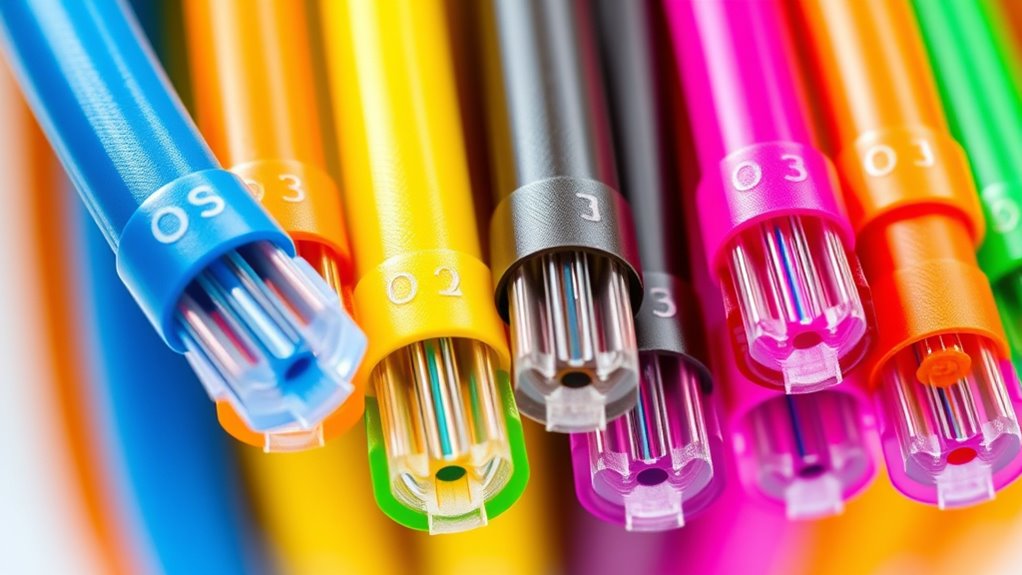Many believe that all fiber cables serve the same purpose, but the truth is, different types like OS1, OS2, OM3, OM4, and OM5 are designed for specific applications. Each has unique features affecting distance, bandwidth, and performance. Understanding these differences can help you choose the right cable for your network needs. So, how do you determine which fiber type suits your setup? The answer lies in their distinct characteristics.
Key Takeaways
- OS1 and OS2 are single-mode fibers optimized for long-distance, high-bandwidth data transmission with small core sizes.
- OM3, OM4, and OM5 are multimode fibers designed for shorter distances and high-speed data transfer in enterprise networks.
- OS2 fiber supports higher bandwidths and longer reach compared to OS1, making it ideal for telecommunications.
- OM3, OM4, and OM5 differ mainly in bandwidth capabilities, with OM5 supporting even higher data rates over multimode fibers.
- Proper handling, cleaning, and installation of fiber connectors are essential for optimal performance across all fiber types.

Fiber cables come in various types, each designed for specific applications and performance needs. When considering which fiber cable to use, understanding the differences between OS1, OS2, OM3, OM4, and OM5 helps you make the right choice. These types vary in core size, mode of transmission, and bandwidth capabilities, impacting their suitability for different environments. For instance, OS1 and OS2 are both single-mode fibers, but OS2 is optimized for longer distances and higher bandwidths, often used in data centers and telecommunications. Meanwhile, OM3, OM4, and OM5 are multimode fibers designed for shorter distances with high data rates, making them ideal for enterprise networks, data centers, and high-speed multimedia applications. Proper handling and connection techniques are essential for maintaining optimal performance and longevity of fiber optic cables. In terms of installation best practices, proper handling of fiber optic connectors is vital. Connectors such as LC, SC, and ST need to be clean and well-maintained to guarantee maximum performance. Dirty or damaged connectors can cause significant signal loss or data transmission errors, which can compromise your entire network. When installing fiber cables, always follow manufacturer recommendations for connector termination and cleaning. Using proper tools, like fiber cleavers and cleaning kits, ensures that connectors are properly prepared, minimizing insertion loss and back reflection. Properly securing and supporting cables prevents bending or stress that could damage the fiber or degrade signal quality.
Frequently Asked Questions
How Do Fiber Cable Types Differ in Installation Requirements?
You’ll find that fiber cable types differ mainly in installation requirements due to connector compatibility and installation complexity. OS1 and OS2 cables are simpler to install, often requiring basic connectors, while OM3, OM4, and OM5 cables may need more specialized connectors for high-speed data. Additionally, higher-performance cables demand careful handling and precise installation practices to prevent damage, making the process more complex for types like OM4 and OM5.
Are Certain Fiber Types More Environmentally Resistant?
Some fiber types offer better environmental durability and resistance to elements, making them ideal for challenging conditions. For example, outdoor-rated cables like OS2 are designed with protective coatings to withstand moisture, temperature fluctuations, and UV exposure. When choosing a fiber, consider the environment’s demands. You’ll find that certain types are specifically engineered for resistance to elements, ensuring reliable performance even in harsh outdoor or industrial settings.
What Are the Cost Differences Among OS1, OS2, OM3, OM4, and OM5?
You’ll find that cost comparison among these fiber types varies mainly due to material expenses. OS1 and OS2 tend to be more affordable because they’re made with simpler materials suited for indoor use. OM3, OM4, and OM5 are more expensive, reflecting their advanced technology and higher performance. Generally, as fiber capabilities improve, material expenses increase, so expect to pay more for the higher-spec options like OM4 and OM5.
Can Fiber Cables Be Upgraded Without Replacing Existing Infrastructure?
While upgrading fiber cables might seem straightforward, it’s not always possible without replacing infrastructure. You can upgrade your fiber network if your existing infrastructure is compatible with the new fiber’s specifications. A fiber upgrade often involves checking connector types, power levels, and transmission distances. If your current setup supports these, you might avoid a full overhaul, saving time and costs. Otherwise, infrastructure compatibility becomes a key factor in your upgrade plan.
How Do Fiber Types Impact Network Latency and Bandwidth?
Fiber types substantially impact your network’s performance by influencing bandwidth and latency. Higher-grade fibers, like OM4 or OM5, deliver greater bandwidth and lower latency, helping you avoid signal degradation over longer distances. Using the right fiber guarantees ideal fiber performance, reducing signal loss and maintaining fast, reliable data transfer. Choosing the appropriate fiber type is essential to minimize latency issues and maximize your network’s capacity.
Conclusion
Choosing the right fiber cable is key to ensuring your network runs smoothly. Whether you opt for OS1, OS2, OM3, OM4, or OM5, understanding their strengths helps you make the right call. Remember, it’s better to be safe than sorry—picking the wrong fiber could cost more down the line. By matching your needs with the right type, you set yourself up for success and avoid unnecessary headaches.









